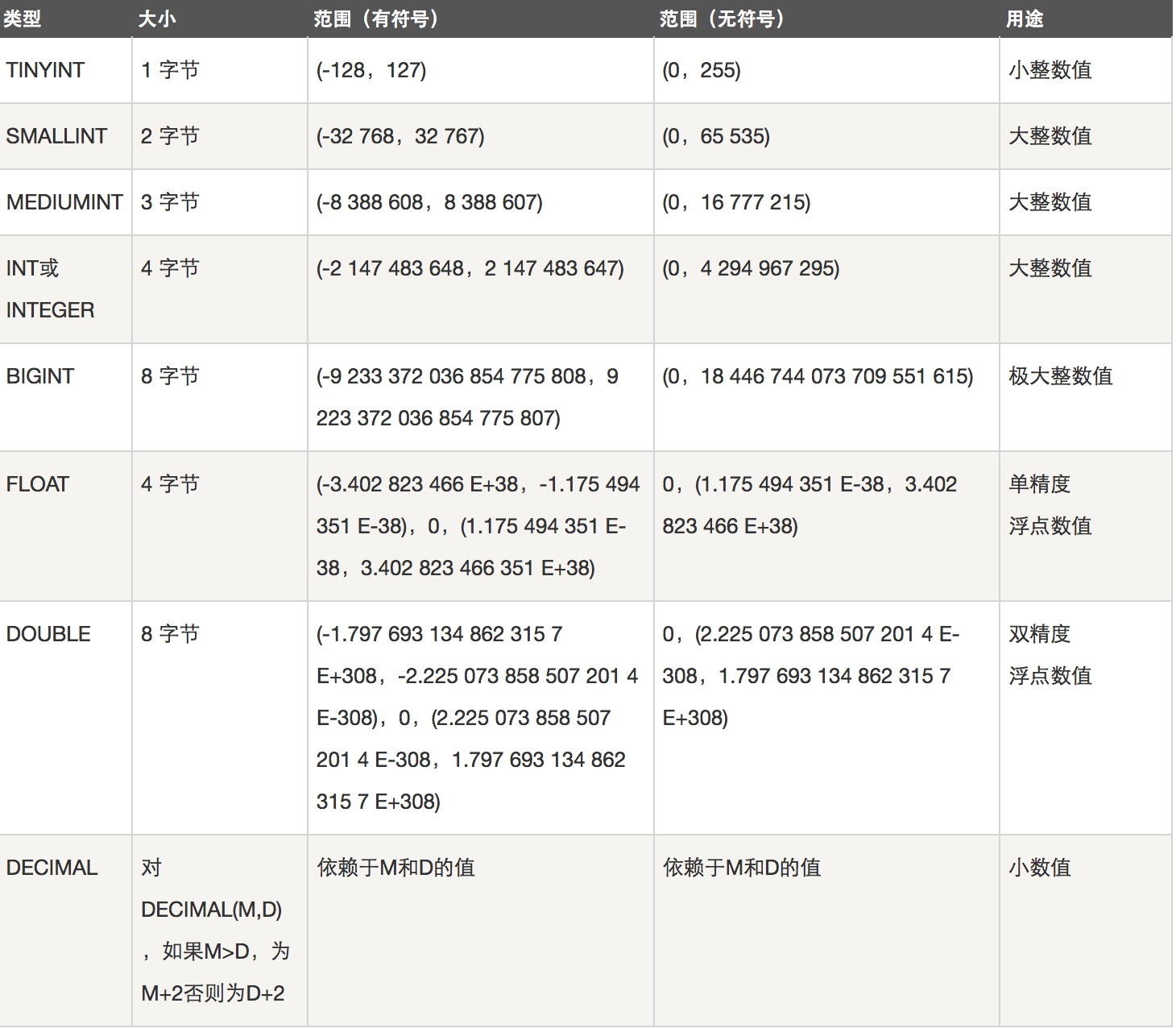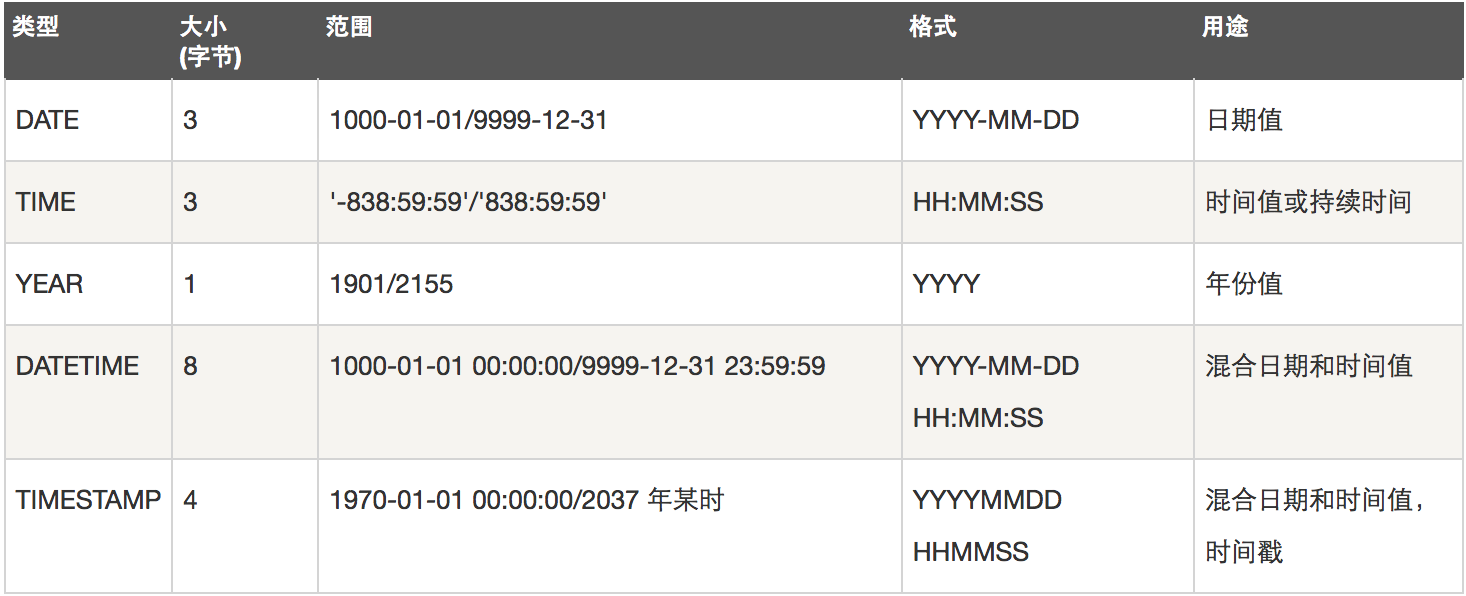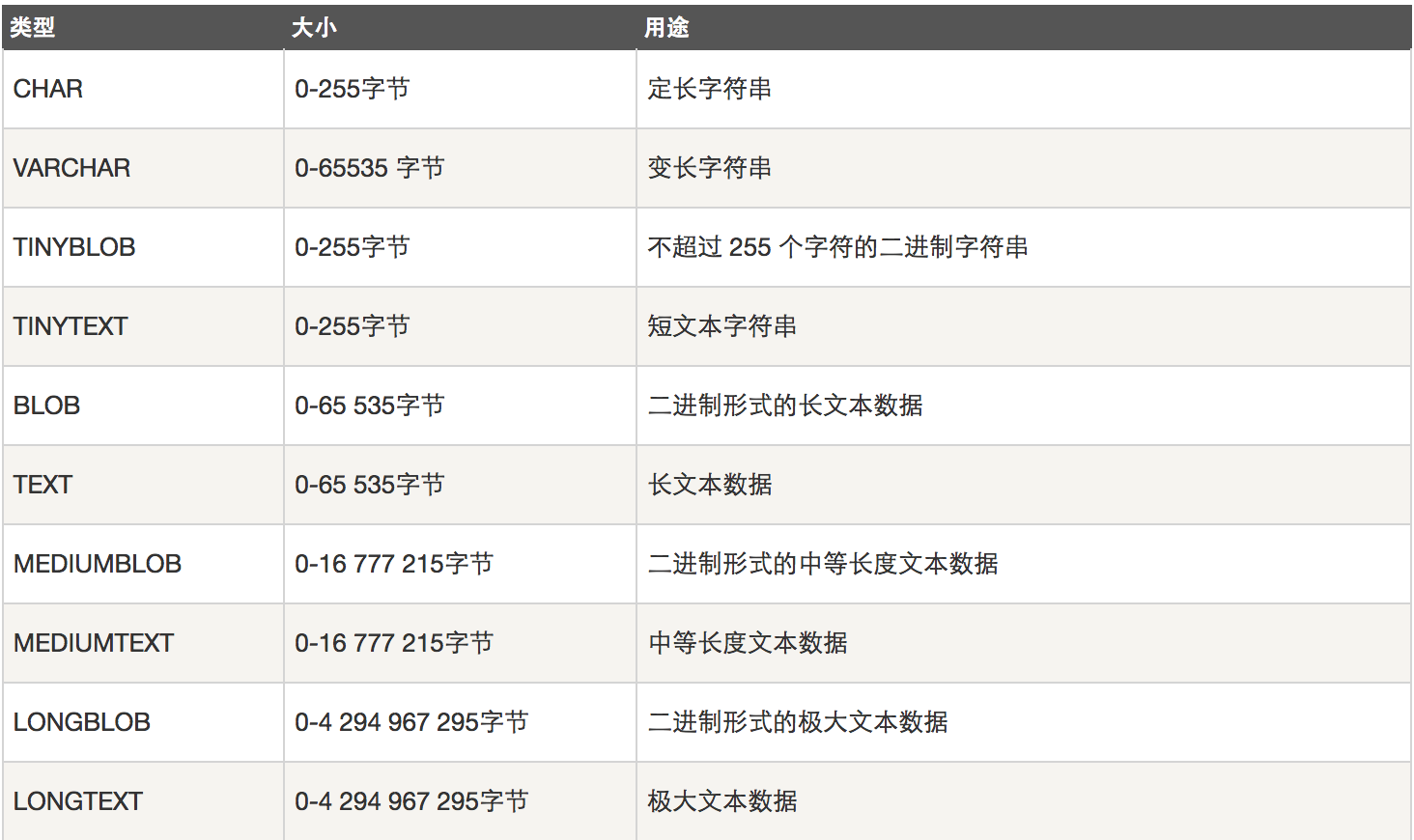MySQL基础
数据库管理软件分类
- 关系型:如sqllite,db2,oracle,access,sql server,MySQL,注意:sql语句通用
- 非关系型:mongodb,redis,memcache
- 可以简单的理解为:关系型数据库需要有表结构,非关系型数据库是key-value存储的,没有表结构
mysql软件安装
一、Window版本
1.安装步骤
- 步骤1:下载:MySQL Community Server 5.7.16 下载
- 步骤2:解压:如果想要让MySQL安装在指定目录,那么就将解压后的文件夹移动到指定目录,如:C:\mysql-5.7.16-winx64
- 步骤3:添加环境变量:【右键计算机】--》【属性】--》【高级系统设置】--》【高级】--》【环境变量】--》【在第二个内容框中找到 变量名为Path 的一行,双击】 --> 【将MySQL的bin目录路径追加到变值值中,用 ; 分割】
- 步骤4:初始化:mysqld --initialize-insecure
- 步骤5:启动MySQL服务:mysqld # 启动MySQL服务
- 步骤6:启动MySQL客户端并连接MySQL服务:mysql -u root -p # 连接MySQL服务器
2.制作MySQL的Windows服务
- 制作MySQL的Windows服务,在终端执行此命令:"c:\mysql-5.7.16-winx64\bin\mysqld" --install 注意:--install前,必须用绝对路径
- 移除MySQL的Windows服务,在终端执行此命令:"c:\mysql-5.7.16-winx64\bin\mysqld" --remove
- 注册成服务之后,以后再启动和关闭MySQL服务时,仅需执行如下命令:
- 启动MySQL服务:net start mysql 关闭MySQL服务:net stop mysql
mysql软件基本管理
一、windows平台下
1.忘记密码
- 关闭mysql服务
- 在cmd中执行:mysqld --skip-grant-tables
- 在cmd中执行:mysql
- 执行如下sql:
- update mysql.user set authentication_string=password('') where user = 'root';
- flush privileges;
- 杀死mysqld: tskill mysqld
- 重启mysql服务
2.配置文件my.ini
- 强调:配置文件中的注释可以有中文,但是配置项中不能出现中文
3.统一字符编码

[mysql] # 设置mysql客户端默认字符集 default-character-set=utf8 [mysqld] #设置3306端口 port = 3306 # 设置mysql的安装目录 basedir=D:\mysql-5.7.18-winx64 # 设置mysql数据库的数据的存放目录 datadir=D:\mysql-5.7.18-winx64\data # 允许最大连接数 max_connections=200 # 服务端使用的字符集默认为8比特编码的latin1字符集 character-set-server=utf8 # 创建新表时将使用的默认存储引擎 default-storage-engine=INNODB
#1. 修改配置文件 [mysqld] character-set-server=utf8 collation-server=utf8_general_ci [client] default-character-set=utf8 [mysql] user="root" password=123456 default-character-set=utf8 #2. 重启服务 #3. 查看修改结果: #show variables like '%char%'
4.小知识点补充
""" 1 如何查看当前具体进程 tasklist tasklist |findstr mysqld 2 如何杀死具体进程(只有在管理员cmd窗口下才能成功) taskkill /F /PID PID号 3 查看当前计算机的运行进程数 services.msc 4 将mysql制作成系统服务 mysqld --install 5 移除mysql系统服务 mysqld --remove
## 当你输入的命令不对 又不想让服务端执行并返回报错信息 可以用\c取消
mysql> \s 查看当前用户信息
6 设置密码 mysqladmin -uroot -p原密码 password 新密码 改命令直接在终端输入即可 无序进入客户端 mysqladmin -uroot -p123 password 123456 7.破解密码 # 1 先关闭当前mysql服务端 命令行的方式启动(让mysql跳过用户名密码验证功能) mysqld --skip-grant-tables # 2 直接以无密码的方式连接 mysql -uroot -p 直接回车 # 3 修改当前用户的密码 update mysql.user set password=password(123456) where user='root' and host='localhost'; # 4 立刻将修改数据刷到硬盘 flush privileges; # 5 关闭当前服务端 然后以正常校验授权表的形式启动 """
存储引擎
- 存储引擎就是表的类型
- 查看MySQL支持的存储引擎show engines;
- 指定表类型/存储引擎:
- create table t1(id int)engine=innodb; #一般用这个
- create table t2(id int)engine=memory;
- create table t3(id int)engine=blackhole;
- create table t4(id int)engine=myisam;
操作库
一、基础操作
1、增
- create database db1 charset utf8;
2、删
- drop database db1;
3、改
- alter database db1 charset utf8;
4、查
- show databases;
- show create database db1;
- select database(); 查看当前操作的是哪个数据库
5、其他操作
- use db1 #选择数据库
二、导入导出
1、导出数据库数据: #语法: # mysqldump -h 服务器 -u用户名 -p密码 数据库名 > 备份文件.sql #示例: #单库备份
mysqldump -uroot -p123 -B db1 > db1.sql
加-B 会多下面两行
CREATE DATABASE /*!32312 IF NOT EXISTS*/ `test` /*!40100 DEFAULT CHARACTER SET utf8 */;
USE `test`;
在以后恢复时,不需要手动进行建库和use库了
mysqldump -uroot -p123 db1 > db1.sql mysqldump -uroot -p123 db1 table1 table2 > db1-table1-table2.sql #多库备份 mysqldump -uroot -p123 --databases db1 db2 mysql db3 > db1_db2_mysql_db3.sql
mysqldump -uroot -p123 --B db1 db2 mysql db3 > db1_db2_mysql_db3.sql
#备份所有库 mysqldump -uroot -p123 --all-databases > all.sql mysqldump -uroot -p123 -A > all.sql
生产环境下,也要加的额外参数 -R, --routines 备份存储过程和函数数据 --triggers 备份触发器数据
mysqldump -uroot -p123 -A -R --triggers > all.sql
2、导入数据库数据: mysqldump -u root -p密码 数据库名称 < 文件路径
#方法一: [root@bubu backup]# mysql -uroot -p123 < /backup/all.sql
#方法二(推荐): mysql> use db1; mysql> SET SQL_LOG_BIN=0; mysql> source /root/db1.sql
#注:如果备份/恢复单个库时,可以修改sql文件 DROP database if exists school; create database school; use school;
3、执行导入文件: create database db5 mysqldump -u root -p -d db5 < db1.sql
操作表
一、基础操作
1、增
|
1
2
3
4
5
6
|
create table 表名(字段名1 类型[(宽度) 约束条件],字段名2 类型[(宽度) 约束条件],字段名3 类型[(宽度) 约束条件])engine=innodb default charset=utf8;#注意:表中的最后一个字段不要加逗号 |
2、删
- drop table t1; #删表
- delete from t1;#清空表 #对于自增的字段,在用delete删除后,再插入值,该字段仍按照删除前的位置继续增长
- truncate t1 #应该用truncate清空表,比起delete一条一条地删除记录,truncate是直接清空表,在删除大表时用它
3、改
|
1
2
3
4
5
6
7
8
9
10
11
12
13
14
15
16
17
18
19
20
21
22
23
24
25
26
27
28
29
30
31
32
33
34
35
36
37
38
39
40
41
42
43
44
45
46
47
48
49
50
51
52
53
54
55
56
57
58
59
60
61
62
63
64
65
66
67
68
69
70
71
72
73
74
75
76
77
78
79
80
81
|
语法:1. 修改表名 alter table 表名 rename 新表名;2. 增加字段 alter table 表名 add 字段名 数据类型 [完整性约束条件…], add 字段名 数据类型 [完整性约束条件…]; alter table 表名 add 字段名 数据类型 [完整性约束条件…] FIRST; alter table 表名 add 字段名 数据类型 [完整性约束条件…] AFTER 字段名; 3. 删除字段 alter table 表名 drop 字段名;4. 修改字段 alter table 表名 modify 字段名 数据类型 [完整性约束条件…]; alter table 表名 change 旧字段名 新字段名 旧数据类型 [完整性约束条件…]; alter table 表名 change 旧字段名 新字段名 新数据类型 [完整性约束条件…];示例:1. 修改存储引擎mysql> alter table t1 -> engine=innodb;2. 添加字段mysql> alter table t1 -> add name varchar(20) not null, -> add age int(3) not null default 22; mysql> alter table t1 -> add stu_num varchar(10) not null after name; //添加name字段之后mysql> alter table t1 -> add sex enum('male','female') default 'male' first; //添加到最前面3. 删除字段mysql> alter table t1 -> drop sex;mysql> alter table t1 -> drop mac;4. 修改字段类型modifymysql> alter table t1 -> modify age int(3);mysql> alter table t1 -> modify id int(11) not null primary key auto_increment; //修改为主键5. 增加约束(针对已有的主键增加auto_increment)mysql> alter table t1 modify id int(11) not null primary key auto_increment;ERROR 1068 (42000): Multiple primary key definedmysql> alter table t1 modify id int(11) not null auto_increment;Query OK, 0 rows affected (0.01 sec)Records: 0 Duplicates: 0 Warnings: 06. 对已经存在的表增加复合主键mysql> alter table t1 -> add primary key(host_ip,port); 7. 增加主键mysql> alter table t1 -> modify name varchar(10) not null primary key;8. 增加主键和自动增长mysql> alter table t1 -> modify id int not null primary key auto_increment;9. 删除主键a. 删除自增约束mysql> alter table t1 modify id int(11) not null; b. 删除主键mysql> alter table t1 -> drop primary key; |
4、查
- desc t1; #查看表结构
- show create table t1\G; #查看表详细结构,可加\G
- show tables;
二、其他操作
1.复制表
- 复制表结构+记录 (key不会复制: 主键、外键和索引): create table new_service select * from service;
- 只复制表结构: create table new1_service select * from service where 1=2;
- create table t4 like t1;
三、数据类型
1、整数类型
- 整数类型:TINYINT SMALLINT MEDIUMINT INT BIGINT
- 作用:存储年龄,等级,id,各种号码等
- 注意:为该类型指定宽度时,仅仅只是指定查询结果的显示宽度,与存储范围无关。其实没有必要指定显示宽度,使用默认的就ok

2、浮点型
- 定点数类型 DEC等同于DECIMAL
- 浮点类型:FLOAT DOUBLE
- 作用:存储薪资、身高、体重、体质参数等
3、日期类型
- DATE TIME DATETIME TIMESTAMP YEAR
- DATETIME的日期范围是1001——9999年,TIMESTAMP的时间范围是1970——2038年。
- 作用:存储用户注册时间,文章发布时间,员工入职时间,出生时间,过期时间等
- create table t1(x datetime not null default now()); # 需要指定传入空值时默认取当前时间
- create table t2(x timestamp); # 无需任何设置,在传空值的情况下自动传入当前时间

4、字符串类型
- 官网:查看
- 注意:char和varchar括号内的参数指的都是字符的长度
- char类型:定长,简单粗暴,浪费空间,存取速度快
- varchar类型:变长,精准,节省空间,存取速度慢
- text类型:用于保存变长的大字符串
- length:查看字节数,char_length:查看字符数

5、枚举类型与集合类型
- 字段的值只能在给定范围中选择,如单选框,多选框
- enum 单选 只能在给定的范围内选一个值,如性别 sex 男male/女female sex enum('male','female','保密'), #在指定范围内,多选一
- set 多选 在给定的范围内可以选择一个或一个以上的值(爱好1,爱好2,爱好3...) hobby set('play','music','read','study') #在指定范围内,多选多
四、表完整性约束
约束条件与数据类型的宽度一样,都是可选参数,作用:用于保证数据的完整性和一致性
- 是否是key: 主键: primary key 外键: foreign key 索引:(index,) 唯一:unique key (uk)
- 是否允许为空,默认null,可设置not null,字段不允许为空,必须赋值,或者也可以自动添加默认值 not null defalut 2
- 无符号unsigned
- 使用0填充 zerofill
1、unsigned
- age int unsigned NOT NULL default 20,
2、not null与default
- age int not null defalut 18,
- age int not null,
3、unique
- #方法1:在某一个字段后用unique: name varchar(20) unique,
- #方法2:在所有字段后单独定义unique: constraint uk_name unique(name) #创建唯一并为其命名uk_name
- #联合唯一:在所有字段后单独定义unique: unique(host,port)
4、primary key
- #方法1:not null+unique: id int not null unique, #主键
- #方法2:在某一个字段后用primary key : id int primary key, #主键
- #方法3:在所有字段后单独定义primary key: constraint pk_name primary key(id); #创建主键并为其命名pk_name
- #多列做主键:在所有字段后单独定义primary key: primary key(ip,port)
5、auto_increment
- 约束字段为自动增长,被约束的字段必须同时被key约束
- id int primary key auto_increment,#primary key auto_increment一般一起使用
6、foreign key
- 多对一:关联方式:foreign key
- 多对多:关联方式:foreign key + 一张新的表
- 一对一:关联方式:foreign key+unique
|
1
2
3
4
5
6
7
8
9
10
11
12
13
14
15
16
17
18
19
20
21
22
23
24
25
26
27
28
29
30
31
32
33
34
35
36
37
38
39
40
41
42
43
44
45
46
47
48
49
50
51
52
53
54
55
56
57
|
"""多对一:关联方式:foreign key多对多:关联方式:foreign key + 一张新的表一对一:关联方式:foreign key+unique=====================多对一=====================create table press(id int primary key auto_increment,name varchar(20));create table book(id int primary key auto_increment,name varchar(20),press_id int not null,foreign key(press_id) references press(id) on delete cascade on update cascade #一个出版社可以出版多本书);=====================多对多=====================create table author(id int primary key auto_increment,name varchar(20));create table book(id int primary key auto_increment,name varchar(20),);#这张表就存放作者表与书表的关系,即查询二者的关系查这表就可以了create table author2book(id int not null unique auto_increment,author_id int not null,book_id int not null,constraint fk_author foreign key(author_id) references author(id) on delete cascade on update cascade, #===多对多====constraint fk_book foreign key(book_id) references book(id) on delete cascade on update cascade, #===多对多====primary key(author_id,book_id));=====================一对一=====================create table customer(id int primary key auto_increment,name varchar(20) not null,qq varchar(10) not null,phone char(16) not null);create table student(id int primary key auto_increment,class_name varchar(20) not null,customer_id int unique, #该字段一定要是唯一的foreign key(customer_id) references customer(id) #外键的字段一定要保证uniqueon delete cascadeon update cascade);""" |
操作记录
一、基础操作
1、增
|
1
2
3
4
5
6
7
8
9
10
11
12
13
14
15
16
17
18
19
20
21
22
23
|
1. 插入完整数据(顺序插入) 语法一: INSERT INTO 表名(字段1,字段2,字段3…字段n) VALUES(值1,值2,值3…值n); 语法二: INSERT INTO 表名 VALUES (值1,值2,值3…值n);2. 指定字段插入数据 语法: INSERT INTO 表名(字段1,字段2,字段3…) VALUES (值1,值2,值3…);3. 插入多条记录 语法: INSERT INTO 表名 VALUES (值1,值2,值3…值n), (值1,值2,值3…值n), (值1,值2,值3…值n); 4. 插入查询结果 语法: INSERT INTO 表名(字段1,字段2,字段3…字段n) SELECT (字段1,字段2,字段3…字段n) FROM 表2 WHERE …; |
2、删
|
1
2
3
4
5
6
7
|
语法: DELETE FROM 表名 WHERE CONITION;示例: DELETE FROM mysql.user WHERE password=’’; |
3、改
|
1
2
3
4
5
6
7
8
9
|
语法: UPDATE 表名 SET 字段1=值1, 字段2=值2, WHERE CONDITION;示例: UPDATE mysql.user SET password=password(‘123’) where user=’root’ and host=’localhost’; |
4、查
①单表
1):单表查询的语法
|
1
2
3
4
5
6
|
SELECT DISTINCT 字段1,字段2... FROM 表名 WHERE 条件 GROUP BY field HAVING 筛选 ORDER BY field LIMIT 限制条数 |
2):关键字的执行优先级
- -> from -> where -> group by-> having-> select-> distinct-> order by-> limit
- 1.找到表:from
- 连表的情况
- 1.1 on 执行on过滤
- 1.2 join 添加外部行
- 2.拿着where指定的约束条件,去文件/表中取出一条条记录
- 3.将取出的一条条记录进行分组group by,如果没有group by,则整体作为一组
- 4.将分组的结果进行having过滤
- 5.执行select
- 6.去重distinct
- 7.将结果按条件排序:order by
- 8.限制结果的显示条数
3):简单查询
|
1
2
3
4
5
6
7
8
9
10
11
12
13
14
15
16
17
18
19
20
21
22
23
24
25
26
27
28
29
30
31
32
33
34
35
36
37
38
39
40
41
42
43
44
45
46
47
48
49
50
51
52
53
54
55
56
57
58
59
60
61
62
63
64
65
66
67
68
69
70
71
72
|
company.employee 员工id id int 姓名 emp_name varchar 性别 sex enum 年龄 age int 入职日期 hire_date date 岗位 post varchar 职位描述 post_comment varchar 薪水 salary double 办公室 office int 部门编号 depart_id int#创建表create table employee(id int not null unique auto_increment,name varchar(20) not null,sex enum('male','female') not null default 'male', #大部分是男的age int(3) unsigned not null default 28,hire_date date not null,post varchar(50),post_comment varchar(100),salary double(15,2),office int, #一个部门一个屋子depart_id int);#查看表结构mysql> desc employee;+--------------+-----------------------+------+-----+---------+----------------+| Field | Type | Null | Key | Default | Extra |+--------------+-----------------------+------+-----+---------+----------------+| id | int(11) | NO | PRI | NULL | auto_increment || name | varchar(20) | NO | | NULL | || sex | enum('male','female') | NO | | male | || age | int(3) unsigned | NO | | 28 | || hire_date | date | NO | | NULL | || post | varchar(50) | YES | | NULL | || post_comment | varchar(100) | YES | | NULL | || salary | double(15,2) | YES | | NULL | || office | int(11) | YES | | NULL | || depart_id | int(11) | YES | | NULL | |+--------------+-----------------------+------+-----+---------+----------------+#插入记录#三个部门:教学,销售,运营insert into employee(name,sex,age,hire_date,post,salary,office,depart_id) values('egon','male',18,'20170301','老男孩驻沙河办事处外交大使',7300.33,401,1), #以下是教学部('alex','male',78,'20150302','teacher',1000000.31,401,1),('wupeiqi','male',81,'20130305','teacher',8300,401,1),('yuanhao','male',73,'20140701','teacher',3500,401,1),('liwenzhou','male',28,'20121101','teacher',2100,401,1),('jingliyang','female',18,'20110211','teacher',9000,401,1),('jinxin','male',18,'19000301','teacher',30000,401,1),('成龙','male',48,'20101111','teacher',10000,401,1),('歪歪','female',48,'20150311','sale',3000.13,402,2),#以下是销售部门('丫丫','female',38,'20101101','sale',2000.35,402,2),('丁丁','female',18,'20110312','sale',1000.37,402,2),('星星','female',18,'20160513','sale',3000.29,402,2),('格格','female',28,'20170127','sale',4000.33,402,2),('张野','male',28,'20160311','operation',10000.13,403,3), #以下是运营部门('程咬金','male',18,'19970312','operation',20000,403,3),('程咬银','female',18,'20130311','operation',19000,403,3),('程咬铜','male',18,'20150411','operation',18000,403,3),('程咬铁','female',18,'20140512','operation',17000,403,3);#ps:如果在windows系统中,插入中文字符,select的结果为空白,可以将所有字符编码统一设置成gbk |
|
1
2
3
4
5
6
7
8
9
10
11
12
13
14
15
16
17
18
19
20
21
22
23
24
25
26
27
28
29
30
31
32
33
34
35
36
37
38
39
|
#简单查询 SELECT id,name,sex,age,hire_date,post,post_comment,salary,office,depart_id FROM employee; SELECT * FROM employee; SELECT name,salary FROM employee;#避免重复DISTINCT SELECT DISTINCT post FROM employee; #通过四则运算查询 SELECT name, salary*12 FROM employee; SELECT name, salary*12 AS Annual_salary FROM employee; SELECT name, salary*12 Annual_salary FROM employee;#定义显示格式 CONCAT() 函数用于连接字符串 SELECT CONCAT('姓名: ',name,' 年薪: ', salary*12) AS Annual_salary FROM employee; CONCAT_WS() 第一个参数为分隔符 SELECT CONCAT_WS(':',name,salary*12) AS Annual_salary FROM employee; 结合CASE语句: SELECT ( CASE WHEN NAME = 'tom' THEN NAME WHEN NAME = 'rose' THEN CONCAT(name,'_VIP') ELSE concat(NAME, 'COMMON') END ) as new_name FROM emp; |
4):WHERE约束
- where字句中可以使用:
- 1. 比较运算符:> < >= <= <> !=
- 2. between 80 and 100 值在10到20之间
- 3. in(80,90,100) 值是10或20或30
- 4. like 'egon%' pattern可以是%或_, %表示任意多字符 , _表示一个字符
- 5. 逻辑运算符:在多个条件直接可以使用逻辑运算符 and or not
|
1
2
3
4
5
6
7
8
9
10
11
12
13
14
15
16
17
18
19
20
21
22
23
24
25
26
27
28
29
30
31
32
33
34
35
36
37
38
39
40
41
42
43
44
45
46
47
|
#1:单条件查询 SELECT name FROM employee WHERE post='sale'; #2:多条件查询 SELECT name,salary FROM employee WHERE post='teacher' AND salary>10000;#3:关键字BETWEEN AND SELECT name,salary FROM employee WHERE salary BETWEEN 10000 AND 20000; SELECT name,salary FROM employee WHERE salary NOT BETWEEN 10000 AND 20000; #4:关键字IS NULL(判断某个字段是否为NULL不能用等号,需要用IS) SELECT name,post_comment FROM employee WHERE post_comment IS NULL; SELECT name,post_comment FROM employee WHERE post_comment IS NOT NULL; SELECT name,post_comment FROM employee WHERE post_comment=''; 注意''是空字符串,不是null ps: 执行 update employee set post_comment='' where id=2; 再用上条查看,就会有结果了#5:关键字IN集合查询 SELECT name,salary FROM employee WHERE salary=3000 OR salary=3500 OR salary=4000 OR salary=9000 ; SELECT name,salary FROM employee WHERE salary IN (3000,3500,4000,9000) ; SELECT name,salary FROM employee WHERE salary NOT IN (3000,3500,4000,9000) ;#6:关键字LIKE模糊查询 通配符’%’ SELECT * FROM employee WHERE name LIKE 'eg%'; 通配符’_’ SELECT * FROM employee WHERE name LIKE 'al__'; |
5):分组查询:GROUP BY
- 1、首先明确一点:分组发生在where之后,即分组是基于where之后得到的记录而进行的
- 2、分组指的是:将所有记录按照某个相同字段进行归类,比如针对员工信息表的职位分组,或者按照性别进行分组等
- 3、为何要分组呢?取每个部门的最高工资?取每个部门的员工数?取男人数和女人数?
- 小窍门:‘每’这个字后面的字段,就是我们分组的依据
- 4、大前提:可以按照任意字段分组,但是分组完毕后,比如group by post,只能查看post字段,如果想查看组内信息,需要借助于聚合函数
- 5. 聚合函数 sum avg min max count
- 6. GROUP BY关键字和GROUP_CONCAT()函数一起使用
- 7. 如果我们用unique的字段作为分组的依据,则每一条记录自成一组,这种分组没有意义
- 8:ONLY_FULL_GROUP_BY #设置成功后,一定要退出,然后重新登录方可生效
|
1
2
3
4
5
6
7
8
9
10
11
12
13
14
15
16
17
18
19
20
21
22
23
24
25
26
27
|
#查看MySQL 5.7默认的sql_mode如下:mysql> select @@global.sql_mode;ONLY_FULL_GROUP_BY,STRICT_TRANS_TABLES,NO_ZERO_IN_DATE,NO_ZERO_DATE,ERROR_FOR_DIVISION_BY_ZERO,NO_AUTO_CREATE_USER,NO_ENGINE_SUBSTITUTION#!!!注意ONLY_FULL_GROUP_BY的语义就是确定select target list中的所有列的值都是明确语义,简单的说来,在ONLY_FULL_GROUP_BY模式下,target list中的值要么是来自于聚集函数的结果,要么是来自于group by list中的表达式的值。#设置sql_mole如下操作(我们可以去掉ONLY_FULL_GROUP_BY模式):mysql> set global sql_mode='STRICT_TRANS_TABLES,NO_ZERO_IN_DATE,NO_ZERO_DATE,ERROR_FOR_DIVISION_BY_ZERO,NO_AUTO_CREATE_USER,NO_ENGINE_SUBSTITUTION';查询岗位名以及岗位包含的所有员工名字 select post,group_concat(name) from employee group by post;查询岗位名以及各岗位内包含的员工个数 select post,count(id) from employee group by post;查询公司内男员工和女员工的个数 select sex,count(id) from employee group by sex;查询岗位名以及各岗位的平均薪资 select post,avg(salary) from employee group by post;查询岗位名以及各岗位的最高薪资 select post,max(salary) from employee group by post;查询男员工与男员工的平均薪资,女员工与女员工的平均薪资 select sex,avg(salary) from employee group by sex; |
6):HAVING过滤
- 1、!!!执行优先级从高到低:where > group by > having
- 2、Where 发生在分组group by之前,因而Where中可以有任意字段,但是绝对不能使用聚合函数。
- 3、Having发生在分组group by之后,因而Having中可以使用分组的字段,无法直接取到其他字段,可以使用聚合函数
|
1
2
3
4
5
6
7
8
|
查询各岗位内包含的员工个数小于2的岗位名、岗位内包含员工名字、个数select post,group_concat(name),count(id) from employee group by post having count(id) < 2;查询各岗位平均薪资大于10000的岗位名、平均工资select post,avg(salary) from employee group by post having avg(salary) > 10000;查询各岗位平均薪资大于10000且小于20000的岗位名、平均工资select post,avg(salary) from employee group by post having avg(salary) > 10000 and avg(salary) < 20000; |
7):查询排序:ORDER BY
|
1
2
3
4
5
6
7
8
9
10
11
12
13
14
15
16
17
|
按单列排序 SELECT * FROM employee ORDER BY salary; SELECT * FROM employee ORDER BY salary ASC; #升序 SELECT * FROM employee ORDER BY salary DESC; #降序按多列排序:先按照age排序,如果年纪相同,则按照薪资排序 SELECT * from employee ORDER BY age, salary DESC;查询所有员工信息,先按照age升序排序,如果age相同则按照hire_date降序排序select * from employee ORDER BY age asc,hire_date desc;查询各岗位平均薪资大于10000的岗位名、平均工资,结果按平均薪资升序排列select post,avg(salary) from employee group by post having avg(salary) > 10000 order by avg(salary) asc;查询各岗位平均薪资大于10000的岗位名、平均工资,结果按平均薪资降序排列select post,avg(salary) from employee group by post having avg(salary) > 10000 order by avg(salary) desc; |
8):限制查询的记录数:LIMIT
|
1
2
3
4
5
6
7
8
|
SELECT * FROM employee ORDER BY salary DESC LIMIT 3; #默认初始位置为0 SELECT * FROM employee ORDER BY salary DESC LIMIT 0,5; #从第0开始,即先查询出第一条,然后包含这一条在内往后查5条SELECT * FROM employee ORDER BY salary DESC LIMIT 5,5; #从第5开始,即先查询出第6条,然后包含这一条在内往后查5条 |
9):使用正则表达式查询
|
1
2
3
4
5
6
7
8
9
10
11
12
13
14
|
SELECT * FROM employee WHERE name REGEXP '^ale';SELECT * FROM employee WHERE name REGEXP 'on$';SELECT * FROM employee WHERE name REGEXP 'm{2}';小结:对字符串匹配的方式WHERE name = 'egon';WHERE name LIKE 'yua%';WHERE name REGEXP 'on$';查看所有员工中名字是jin开头,n或者g结果的员工信息select * from employee where name regexp '^jin.*[gn]$'; |
10):练习
|
1
2
3
4
5
6
7
8
9
10
11
12
13
14
15
16
17
|
查询每个部门最新入职的那位员工#链表方式:SELECT *FROM employee AS t1INNER JOIN ( SELECT post, max(hire_date) max_date FROM employee GROUP BY post) AS t2 ON t1.post = t2.postWHERE t1.hire_date = t2.max_date; |
②多表
|
1
2
3
4
5
6
7
8
9
10
11
12
13
14
15
16
17
18
19
20
21
22
23
24
25
26
27
28
29
30
31
32
33
34
35
36
37
38
39
|
#建表create table department(id int,name varchar(20) );create table employee(id int primary key auto_increment,name varchar(20),sex enum('male','female') not null default 'male',age int,dep_id int);#插入数据insert into department values(200,'技术'),(201,'人力资源'),(202,'销售'),(203,'运营');insert into employee(name,sex,age,dep_id) values('egon','male',18,200),('alex','female',48,201),('wupeiqi','male',38,201),('yuanhao','female',28,202),('liwenzhou','male',18,200),('jingliyang','female',18,204);#查看表结构和数据mysql> desc department;mysql> desc employee;mysql> select * from department;mysql> select * from employee; |
1):多表连接查询
|
1
2
3
4
5
6
7
8
9
10
11
12
13
14
15
|
#重点:SELECT 字段列表 FROM 表1 INNER|LEFT|RIGHT JOIN 表2 ON 表1.字段 = 表2.字段;#示例1:以内连接的方式查询employee和department表,并且employee表中的age字段值必须大于25,即找出年龄大于25岁的员工以及员工所在的部门select employee.name,department.name from employee inner join department on employee.dep_id = department.id where age > 25;#示例2:select employee.id,employee.name,employee.age,department.name from employee,department where employee.dep_id = department.id and age > 25 order by age asc; |
2):交叉连接
- 不适用任何匹配条件。生成笛卡尔积
- select * from employee,department;
3):内连接只连接匹配的行inner join
- 找两张表共有的部分,相当于利用条件从笛卡尔积结果中筛选出了正确的结果
- select employee.id,employee.name,employee.age,employee.sex,department.name from employee inner join department on employee.dep_id=department.id; #推荐这样写
- select employee.id,employee.name,employee.age,employee.sex,department.name from employee,department where employee.dep_id=department.id;#效果一样
4):外链接之左连接:优先显示左表全部记录left join
- 以左表为准
- 本质就是:在内连接的基础上增加左边有右边没有的结果
- select employee.id,employee.name,department.name as depart_name from employee left join department on employee.dep_id=department.id;
5):外链接之右连接:优先显示右表全部记录right join
- 以右表为准
- 本质就是:在内连接的基础上增加右边有左边没有的结果
- select employee.id,employee.name,department.name as depart_name from employee right join department on employee.dep_id=department.id;
6):全外连接:显示左右两个表全部记录
- 全外连接:在内连接的基础上增加左边有右边没有的和右边有左边没有的结果
- 注意:mysql不支持全外连接 full JOIN
- 强调:mysql可以使用此种方式间接实现全外连接
- select * from employee left join department on employee.dep_id = department.id union select * from employee right join department on employee.dep_id = department.id;
- #注意 union与union all的区别:union会去掉相同的纪录
7):子查询
- 1:子查询是将一个查询语句嵌套在另一个查询语句中。
- 2:内层查询语句的查询结果,可以为外层查询语句提供查询条件。
- 3:子查询中可以包含:IN、NOT IN、ANY、ALL、EXISTS 和 NOT EXISTS等关键字
- 4:还可以包含比较运算符:= 、 !=、> 、< 等
|
1
2
3
4
5
6
7
8
9
10
11
12
13
14
15
16
17
18
19
20
21
|
#查询平均年龄在25岁以上的部门名select id,name from department where id in (select dep_id from employee group by dep_id having avg(age) > 25);#查看技术部员工姓名select name from employee where dep_id in (select id from department where name='技术');#查看不足1人的部门名(子查询得到的是有人的部门id)select name from department where id not in (select distinct dep_id from employee);#比较运算符:=、!=、>、>=、<、<=、<>#查询大于所有人平均年龄的员工名与年龄select name,age from emp where age > (select avg(age) from emp);#查询大于部门内平均年龄的员工名、年龄select t1.name,t1.age from emp t1inner join (select dep_id,avg(age) avg_age from emp group by dep_id) t2on t1.dep_id = t2.dep_idwhere t1.age > t2.avg_age; |
|
1
2
3
4
5
6
7
8
9
10
11
12
13
14
|
8):补充EXISTSEXISTS关字键字表示存在。在使用EXISTS关键字时,内层查询语句不返回查询的记录。 而是返回一个真假值。True或False 当返回True时,外层查询语句将进行查询;当返回值为False时,外层查询语句不进行查询#department表中存在dept_id=203,Turemysql> select * from employee -> where exists -> (select id from department where id=200);#department表中存在dept_id=205,Falsemysql> select * from employee -> where exists -> (select id from department where id=204);Empty set (0.00 sec) |
二、权限管理
1、授权表;
- user 针对:所有数据,所有库下所有表,以及表下的所有字段
- db 针对:某一数据库,该数据库下的所有表,以及表下的所有字段
- tables_priv 针对:某一张表,以及该表下的所有字段
- columns_priv 针对:某一个字段
2、授权(对库,对表,对字段);
- 查看帮助:help grant
- 常用权限有:select,update,alter,delete
- all可以代表除了grant之外的所有权限
grant select,insert,update on db1.* to 'tom'@'%'; grant select,insert,update on db1.t1 to 'tom'@'%'; grant all privileges on db1.t1 to 'tom'@'%'; #针对所有库的授权:*.* grant select on *.* to 'tom'@'localhost' identified by '123'; #只在user表中可以查到tom用户的select权限被设置为Y #针对某一数据库:db1.* grant select on db1.* to 'tom'@'%' identified by '123'; #只在db表中可以查到tom用户的select权限被设置为Y #针对某一个表:db1.t1 grant select on db1.t1 to 'tom'@'%' identified by '123'; #只在tables_priv表中可以查到tom用户的select权限 #针对某一个字段: grant select (id,name),update (age) on db1.t3 to 'tom'@'localhost' identified by '123'; #可以在tables_priv和columns_priv中看到相应的权限 select * from tables_priv where user='tom'\G select * from columns_priv where user='tom'\G #查看权限 show grants for 'tom'@'%'; #删除权限 revoke all privileges on db1.t1 from 'tom'@'%'; revoke select on db1.* from 'tom'@'%';





